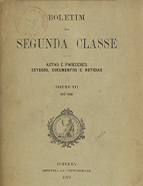

................................
In summary, this ACL publication, which filled a gap in documenting minutes and opinions from the Regeneration to the early 20th century, reflects many of the key elements that characterise the life of an academy in modern times. These include: debate and polemics over which topics should take precedence— literary or scholarly; The inclusion or exclusion of politicians and women as members; The evolving emphasis on session minutes and the extensive transcription of documents; Collective projects inherited from the past— such as the Portugaliae Monumenta Historica , the Corpo Diplomático , and the Quadro Elementar — and their interruptions due to the perceived need for archival research for historical summaries, as exemplified by António Ferrão; The variable timeliness of printing volumes and fascicles, which made the Boletim da Segunda Classe (or Boletim das Letras [Bulletin of Arts and Humanities] for its co-evaluated public) either a desirable product for its novelty or uninteresting due to being outdated.
Active bibliography: Boletim da Segunda Classe (Boletim da Classe de Letras , vols. XIII-XV), Lisboa, por ordem e na Tipografia da Academia, vols. I-V, 1903-1912, IX, 1915 e XX (1ª e 2ª partes), s.d.; Coimbra, vols. VI-VII, 1913-1914 e VIII-XIX, 1916-1933.
Passive bibliography: António Ferrão, As Causas «Ideais» da Conflagração e a Função Pedagógica das Academias Científicas após a Guerra … , Coimbra, Imprensa da Universidade, 1918; Catálogo das Publicações da Academia, Lisboa, Academia das Ciências de Lisboa, 1983, pp. 20-22 e 60; Daniel Protásio, verbete sobre António Ferrão no Dicionário de Historiadores Portugueses .
Daniel Estudante Protásio
This work is financed by national funds through FCT - Foundation for Science and Technology, I.P, in the scope of the projects UIDB/04311/2020 and UIDP/04311/2020.
